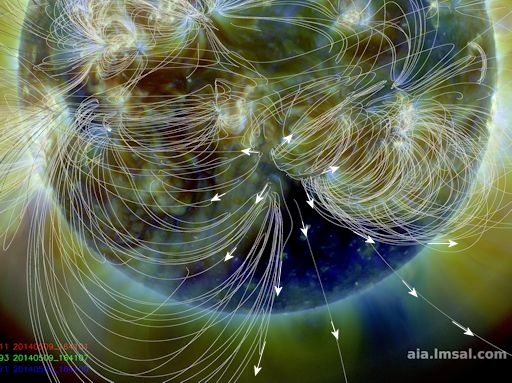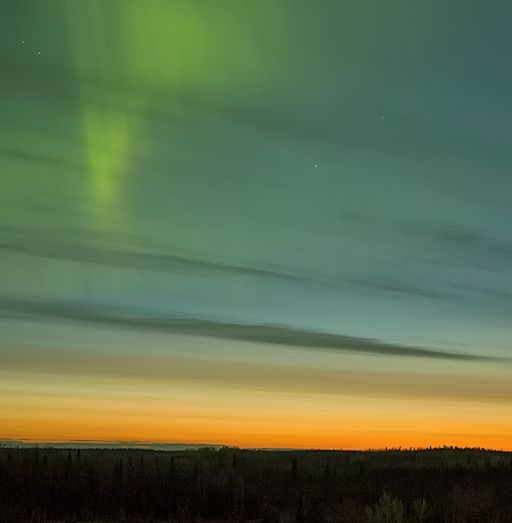Listen to radar echoes from satellites and meteors, live on listener-supported Space Weather Radio. | | | GET READY FOR A NEW METEOR SHOWER: May 24th could be a big day for meteor astronomy. That's when Earth is expected to pass through a cloud of debris from comet 209P/LINEAR, producing a never-before-seen meteor shower. Meteor rates could exceed 200 per hour, and some forecasters have even mentioned the possibility of a meteor storm. Get the full story from Science@NASA. SOUTHERN CORONAL HOLE: Imagine what it would be like if, from time to time, a hole opened up in Earth's atmosphere and air went blowing out into space. On the sun, this happens all the time. The openings are called "coronal holes." NASA's Solar Dynamics Obervatory is monitoring one right now; it is the dark wedge-shaped region in this extreme ultraviolet image of the sun's southern hemisphere: 
Coronal holes are places in the sun's atmosphere where the magnetic field bends back and allows gas to escape. From such openings, solar wind blows out into space. A stream of solar wind flowing from this particular coronal hole could reach Earth on May 11-12, sparking auroras when it arrives. On the other hand, the stream might sail south of our planet, delivering only a glancing blow. Stay tuned for updates. Aurora alerts: text, voice Realtime Space Weather Photo Gallery WEAK INTERPLANETARY SHOCK SPARKS AURORAS: An interplanetary shock wave, origin unknown, hit Earth's magnetic field during the late hours of May 7th. Although the weak impact did not spark a geomagnetic storm, solar wind conditions in the wake of the shock have been favorable for auroras. Nancy Dean took this picture last night on Mount Spur, Alaska: 
"The sunset was still showing strong on May 8th when the Northern Lights came out to dance across the Alaskan sky," says Dean. As northern spring unfolds, persistent twilight is spreading into the night skies of Alaska. It takes a bright display of auroras to be seen against such a backdrop. Dean's photo is evidence that a weak shock does not necessarily produce weak auroras. More lights are possible tonight. NOAA forecasters estimate a 30% chance of polar geomagnetic storms as Earth exits the wake of the shock. Solar flare alerts: text, voice Realtime Aurora Photo Gallery
Realtime Mars Photo Gallery
Realtime Comet Photo Gallery Every night, a network of NASA all-sky cameras scans the skies above the United States for meteoritic fireballs. Automated software maintained by NASA's Meteoroid Environment Office calculates their orbits, velocity, penetration depth in Earth's atmosphere and many other characteristics. Daily results are presented here on Spaceweather.com. On May. 8, 2014, the network reported 23 fireballs.
(16 sporadics, 7 eta Aquariids) 
In this diagram of the inner solar system, all of the fireball orbits intersect at a single point--Earth. The orbits are color-coded by velocity, from slow (red) to fast (blue). [Larger image] [movies]
Potentially Hazardous Asteroids ( PHAs) are space rocks larger than approximately 100m that can come closer to Earth than 0.05 AU. None of the known PHAs is on a collision course with our planet, although astronomers are finding new ones all the time. On May 9, 2014 there were potentially hazardous asteroids. Notes: LD means "Lunar Distance." 1 LD = 384,401 km, the distance between Earth and the Moon. 1 LD also equals 0.00256 AU. MAG is the visual magnitude of the asteroid on the date of closest approach. | | The official U.S. government space weather bureau | | | The first place to look for information about sundogs, pillars, rainbows and related phenomena. | | | Researchers call it a "Hubble for the sun." SDO is the most advanced solar observatory ever. | | | 3D views of the sun from NASA's Solar and Terrestrial Relations Observatory | | | Realtime and archival images of the Sun from SOHO. | | | from the NOAA Space Environment Center | | | the underlying science of space weather | | 
